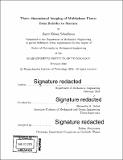| dc.contributor.advisor | Alexandra H. Techet. | en_US |
| dc.contributor.author | Scharfman, Barry Ethan | en_US |
| dc.contributor.other | Massachusetts Institute of Technology. Department of Mechanical Engineering. | en_US |
| dc.date.accessioned | 2016-07-01T18:44:01Z | |
| dc.date.available | 2016-07-01T18:44:01Z | |
| dc.date.copyright | 2016 | en_US |
| dc.date.issued | 2016 | en_US |
| dc.identifier.uri | http://hdl.handle.net/1721.1/103479 | |
| dc.description | Thesis: Ph. D., Massachusetts Institute of Technology, Department of Mechanical Engineering, 2016. | en_US |
| dc.description | Cataloged from PDF version of thesis. | en_US |
| dc.description | Includes bibliographical references (pages 173-178). | en_US |
| dc.description.abstract | Experimental spray flow analysis is a difficult fluid dynamics problem because of the high optical density of many sprays. Flow features such as ligaments and droplets break off the bulk liquid volume during the atomization process and often occlude each other in images of sprays. Therefore, accurate feature detection and measurement requires advanced three-dimensional (3D) imaging techniques. In this thesis, 3D computational photographic methods including light field imaging (LFI) and synthetic aperture (SA) refocusing are combined and extended to resolve multiphase flows in 3D over time. Multiple photographs of the same scene are recorded with a large depth of field by each of the cameras in an array. After calibrating the cameras, images from each of the cameras are transformed and combined at each desired depth to construct a 3D focal stack of the scene. Each depth slice image has a narrow depth of field. Features that are physically located at a particular depth appear in focus, while objects located at other depths appear blurred. The SA output focal stack images can be filtered to physically locate features that are small relative to the field of view. However, this task becomes more difficult for relatively larger features due to the presence of bigger out-of-focus blur artifacts. In this thesis, a Synthetic Aperture Feature Extraction (SAFE) technique has been developed to measure blobs in 3D. First, raw images from each of the array cameras are preprocessed. Blobs are detected and converted to white pixels, while the rest of the image is made black. These binary images are then refocused using a multiplicative refocusing method that only preserves the detected blobs in the neighborhood of their physical 3D location. For blobs that can be approximated as spheres, 3D centroids and radii can then be reliably extracted after post-processing the focal image stack. This process can be repeated over time while tracking particle motion. As a result, 3D spatial, size, and velocity data distributions can be calculated as functions of time to better understand the flow dynamics and characteristics. The SAFE technique has been verified using simulations and experiments involving flow of spherical soap bubbles in air. This 3D SAFE method is also applied to the emission of mucosalivary fluid from the mouth during sneezing. Sneezes feature turbulent, multiphase flows containing potentially pathogen-bearing droplets that can play a key role in the spread of numerous infectious diseases, including influenza, SARS, and, possibly, Ebola. The range of contamination of the droplets is largely determined by their size. Despite recent efforts, no consensus on the drop size distribution from violent expirations can be found in the literature. This uncertainty inhibits a mechanistic understanding of disease transmission. Here, high-speed imaging is used to visualize previously unreported dynamics of fluid fragmentation in detail at the exit of the mouth. Droplet radii, positions, velocities, and other measurements are calculated using blob detection and tracking. This is done in two dimensions by recording the scene with a high-speed side and top camera. 3D experiments are then performed using an array of nine cameras and implementing the aforementioned 3D SAFE imaging method. The 3D sneeze data are important for a more complete understanding of the range and contamination potential of airborne disease transmission. | en_US |
| dc.description.statementofresponsibility | by Barry Ethan Scharfman. | en_US |
| dc.format.extent | 178 pages | en_US |
| dc.language.iso | eng | en_US |
| dc.publisher | Massachusetts Institute of Technology | en_US |
| dc.rights | M.I.T. theses are protected by copyright. They may be viewed from this source for any purpose, but reproduction or distribution in any format is prohibited without written permission. See provided URL for inquiries about permission. | en_US |
| dc.rights.uri | http://dspace.mit.edu/handle/1721.1/7582 | en_US |
| dc.subject | Mechanical Engineering. | en_US |
| dc.title | Three dimensional imaging of multiphase flows : from bubbles to sneezes | en_US |
| dc.title.alternative | 3 dimensional imaging of multiphase flows : from bubbles to sneezes | en_US |
| dc.title.alternative | 3-D dimensional imaging of multiphase flows : from bubbles to sneezes | en_US |
| dc.type | Thesis | en_US |
| dc.description.degree | Ph. D. | en_US |
| dc.contributor.department | Massachusetts Institute of Technology. Department of Mechanical Engineering | |
| dc.identifier.oclc | 952344453 | en_US |
